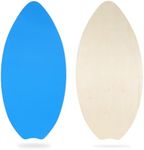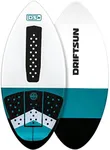Buying Guide for the Best Skimboards
Choosing the right skimboard can greatly enhance your experience on the water. Skimboarding is a fun and exciting sport that requires the right equipment to match your skill level, body type, and the conditions you'll be riding in. When selecting a skimboard, it's important to consider several key specifications to ensure you get the best fit for your needs. Understanding these specs will help you make an informed decision and enjoy your time on the waves to the fullest.SizeThe size of the skimboard is crucial as it affects your ability to control the board and perform tricks. Skimboards come in various sizes, typically measured in inches. Smaller boards (under 45 inches) are more maneuverable and better for tricks, making them ideal for lighter riders or those with more experience. Medium-sized boards (45-50 inches) offer a balance between control and stability, suitable for intermediate riders. Larger boards (over 50 inches) provide more stability and are better for beginners or heavier riders. To pick the right size, consider your weight and skill level: lighter and more experienced riders can opt for smaller boards, while beginners and heavier riders should go for larger boards.
ShapeThe shape of the skimboard influences its performance on different types of water. There are two main shapes: wave riding and flatland. Wave riding boards have a more curved, pointed nose and are designed for catching and riding waves. Flatland boards are typically more symmetrical and flat, making them better for performing tricks on flat water or sand. If you plan to ride waves, choose a wave riding board. If you prefer flatland tricks or riding on shallow water, a flatland board is the better option.
MaterialSkimboards are made from different materials, each offering unique benefits. The most common materials are wood and foam. Wooden skimboards are heavier and more durable, making them suitable for flatland skimboarding and beginners. Foam boards are lighter and more buoyant, which helps with wave riding and is preferred by more experienced riders. When choosing the material, consider where you'll be skimboarding and your skill level: beginners and flatland riders might prefer wood, while experienced riders and those riding waves might opt for foam.
RockerThe rocker refers to the curvature of the skimboard from nose to tail. A board with more rocker (more curve) is better for wave riding as it helps prevent the nose from digging into the water. Boards with less rocker (flatter) are faster on flat water and better for performing tricks. If you plan to ride waves, look for a board with a higher rocker. For flatland skimboarding and tricks, a board with less rocker will be more suitable.
ThicknessThe thickness of the skimboard affects its buoyancy and performance. Thicker boards are more buoyant and stable, making them easier to ride for beginners and better for wave riding. Thinner boards are less buoyant but more responsive and better for performing tricks. When choosing the thickness, consider your skill level and the type of skimboarding you'll be doing: beginners and wave riders should opt for thicker boards, while experienced riders and those focusing on tricks might prefer thinner boards.




















